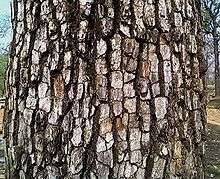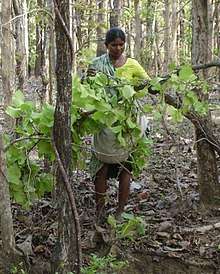Diospyros melanoxylon
| Coromandel ebony | |
|---|---|
 | |
| Bark of the Coromandel ebony | |
| Scientific classification | |
| Kingdom: | Plantae |
| Clade: | Angiosperms |
| Clade: | Eudicots |
| Clade: | Asterids |
| Order: | Ericales |
| Family: | Ebenaceae |
| Genus: | Diospyros |
| Species: | D. melanoxylon |
| Binomial name | |
| Diospyros melanoxylon Roxb.[1] | |
| Synonyms[2] | |
| |
Diospyros melanoxylon, the Coromandel ebony or East Indian ebony, is a species of flowering tree in the family Ebenaceae native to India and Sri Lanka; it has a hard, dry bark. Its common name derives from Coromandel, the coast of southeastern India. Locally it is known as temburini or by its Hindi name tendu. In Odisha, Jharkhand, and Assam, it is known as kendu. The leaves can be wrapped around tobacco to create the Indian beedi,[3] which has outsold conventional cigarettes in India.[4]

Pharmacology
The leaf of the tree contains valuable flavones.[5] The pentacyclic triterpenes found in the leaves possess antimicrobial properties,[6] while the bark shows antihyperglycemic activity.[7] The bark of four Diospyros species found in India has been determined to have significant antiplasmodial effects against Plasmodium falciparum, which causes malaria in humans.[8]
Method of collection
Tendu leaves are used as a wrapper for Beedi. During the summer fresh leaves are produced by the suckers coming up from the soil. This is also enhanced by setting fire beneath Tendu tree. The fresh leaves are hand-picked by the tribals and dried in sun for 10 days. This practice is seen in Maharashtra, M.P., Orissa and Chhattisgarh states of India. The State Government gives the license for collection and processing of the tendu leaves through tender every year.[9]
References
- ↑ "Diospyros melanoxylon". Germplasm Resources Information Network (GRIN). Agricultural Research Service (ARS), United States Department of Agriculture (USDA). Retrieved 2009-04-09.
- ↑ "The Plant List: A Working List of All Plant Species".
- ↑ Lal, Pranay (25 May 2009). "Bidi – A short history" (PDF). Current Science. Bangalore, India: Current Science Association. 96 (10): 1335–1337. Retrieved 5 May June 2013. Check date values in:
|accessdate=(help) - ↑ "...bidis command 48 percent of the market while chewing tobacco commands 38 percent and cigarettes 14 percent..." Archived 6 March 2012 at the Wayback Machine., "The Tax Treatment of Bidis", tobaccofreeunion.org
- ↑ NEW FLAVONOIDS FROM THE LEAVES OF DIOSPYROS MELANOXYLON, Uppuluri V. Mallavadhani and Anita Mahapatra
- ↑ Antimicrobial Activity of Some Pentacyclic Triterpenes and Their Synthesized 3-O-Lipophilic Chains, Uppuluri Venkata MALLAVADHANI,*, a Anita MAHAPATRA, a Kaiser JAMIL, b and Peddi Srinivasa REDDY, Biol. Pharm. Bull. 27(10) 1576—1579 (2004) Vol. 27, No. 10
- ↑ Antihyperglycemic effect of Diospyros melanoxylon (Roxb.) bark against Alloxan-induced diabetic rats Jadhav J. K*.Masirkar V. J., Deshmukh V. N.International Journal of PharmTech Research CODEN( USA): IJPRIF ISSN 0974-4304, Vol.1, No.2, pp 196-200, April–June 2009
- ↑ Investigation of Indian Diospyros Species for Antiplasmodial Properties, V. S. Satyanarayana Kantamreddi and Colin W. Wright. eCAM 2008;5(2)187–190
- ↑ "Working Plan of central Chanda forest division, Chandrapur" (PDF). mahaforest.nic.in. Retrieved 2018-05-28.